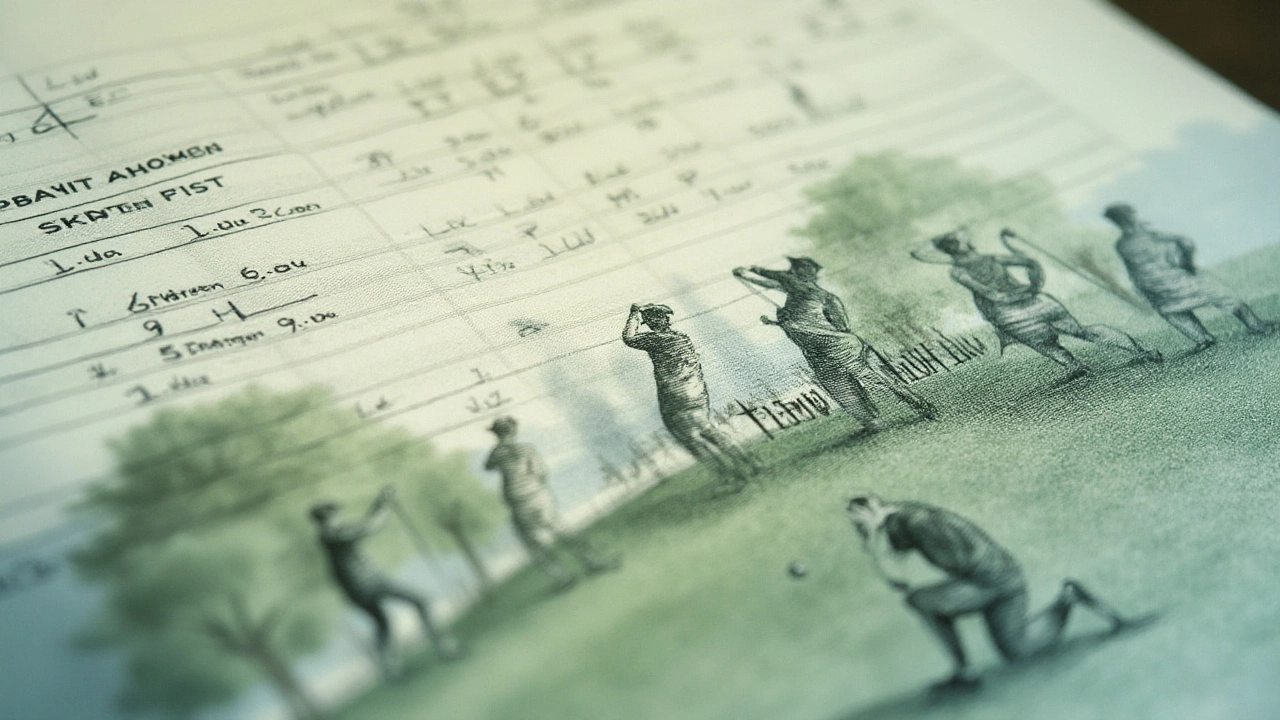
Golf, a game steeped in tradition and precision, uses various terms to define its rules and expectations, with 'par' being among the most foundational. But what exactly is 'par,' and why is it so critical to the game?
The concept of 'par' sets a benchmark for players, guiding them on what score to aim for on each hole. Historically, this term has evolved, tracing back to the early days of golf when standards were established to unify competitions.
Understanding par not only enhances one's appreciation of the sport but also aids in improving performance on the course. Whether you're an amateur or a seasoned golfer, learning about the origins and implications of par can deepen your connection to this beloved sport.
- Origins of Par in Golf
- How Par Influences Gameplay
- Significance of Par in Course Design
- Tips for Playing to Par
Origins of Par in Golf
Diving into the rich tapestry of golfing history, one finds that the term par has roots extending back to the late 19th century. Developed to bring a sense of uniformity to this ancient game, par was first introduced to offer a standard by which golfers could measure their performance. Interestingly, the term was borrowed from an entirely different context, that of stocks and bonds, where it described a nominal or face value. Golfing pioneers adopted this idea to signify the number of strokes an expert golfer would need to finish a hole or the entire course.
The honor of formally adopting the idea of par within golf is often credited to the English golfing community. It is said that during a meeting in England at the Great Exhibition in 1870, the standards of golf scoring were discussed, and the concept of par was officially recognized. By the time the American golfing scene began to flourish in the early 20th century, this British import was firmly entrenched. Golfers found comfort and challenge in aiming for par, making it an essential part of the game.
Modern-day golf courses now use detailed mathematical analysis to set their pars, taking into account the hole length and possible obstacles. Some historians claim that the Royal and Ancient Golf Club of St Andrews, famously known for upholding tradition, played a key role in formalizing par as an essential component of golf. With par set as a benchmark, it became easier to organize tournaments and compare results across different courses. According to an article in Golf Digest, Bobby Jones, a legendary figure in golf, was quoted saying, "Par is merely where excellence begins." This encapsulated the spirit of par, not as a limit but a starting line for achieving greatness.

How Par Influences Gameplay
When navigating a golf course, understanding par is essential in shaping your strategy and approach to the game. Par serves as a benchmark, indicating the expected number of strokes a player should take to complete a hole. This includes teeing off, reaching the green, and putting the ball into the hole. Every golf hole has a designated par, typically ranging from three to five strokes, and this directly affects how players plan their shots. For instance, on a par three hole, a player might aim for the green in just one stroke and save two more for putting, while on a par five, reaching the green in fewer strokes than allocated can set them up for a birdie, bogie or even an eagle.
Strategically, par becomes a constant companion in a player's mind during each round of golf. It dictates whether they play conservatively or take risks, especially when in competition or attempting to break personal records. Par not only informs the golfer about the layout complexity but also subtly hints at the distance and obstacles they will face. In professional tournaments like The Masters or The Open Championship, players are constantly aware of how their performance matches against par. Many legendary moments in golf history, like Tiger Woods' incredible shots at Augusta, were shaped by his understanding of par and his ability to cleverly navigate each hole with it in mind.
"Par is the silent referee of golf, always present, demanding respect, and attention to detail," said renowned golf historian Peter Alliss. This perspective highlights how intrinsically par is woven into golf's fabric.
On a broader level, par not only influences individual play but also comparisons among competitors. In tournaments, the leaderboard often highlights players' scores in relation to par, indicating who is over, under, or even par throughout the event. This system makes the sport accessible to viewers and participants, allowing a clear picture of who leads the game and who is trying to catch up. It goes beyond numbers, introducing a relatable human element where shooting 'even par' or 'under par' becomes a testament to the player's skill, concentration, and determination.
Par also plays a crucial role in encouraging improvement and shaping a player’s overall golfing experience. For many beginners, aiming to consistently achieve par can be an initial goal, representing a step towards mastering the course complexities. This development cycle is crucial; as golfers improve, they aspire to go beyond par more frequently, aiming for birdies or eagles. By setting these realistic targets, players can incrementally hone their skills without being overwhelmed, making par an essential stepping stone in the journey from novice to expert.
The design of golf courses often revolves around par as well. Course architects meticulously plan each hole’s length, obstacles, and layout to match its designated par, ensuring challenges are fair but engaging. Par serves as the linchpin for enticing and rewarding gameplay. Golf courses often feature a mixture of par threes, fours, and fives, creating a diverse landscape that challenges various aspects of a player's ability - from precise shots over water on a par three to powerful drives on longer par fives. This design philosophy means that no two courses are ever truly alike, and each round of golf offers a new adventure waiting to be tackled. With such a critical role in both playing and understanding golf, embracing par is key not just for the scorecard but for the heart and soul of the game.

Significance of Par in Course Design
When it comes to designing golf courses, the concept of par serves as the backbone around which every aspect of the layout is crafted. Each hole's par is determined by a combination of factors, including its length, terrain, and intended level of challenge for players. For instance, a hole designated as a par 3 is typically shorter and may demand precision and skill rather than sheer distance of the shot, reflecting a highly strategic layout approach. In contrast, par 5 holes are generally longer and require players to strategize their strokes over distance, often involving more than just power to achieve a par score.
The thoughtful determination of par goes beyond mere labeling, deeply influencing how a course plays. Course architects use par to balance the pace and rhythm of the game, ensuring that players experience a blend of challenge and enjoyment. The placement of obstacles like sand traps and water hazards, and the design of greens and fairways are intricately tied to the desired par for each hole. Elevation changes and natural features of the landscape are also considered in the equation, lending each course a unique character and playing experience that aligns with the intended par.
In popular golf courses around the world, different design philosophies revolve around the use of par to set a course's difficulty level. This is where creativity meets tradition, as designers often pay homage to classic courses while innovating with new techniques. A well-designed course will have strategic par allocations in a way that tests golfers of all skill levels, providing an equitable playing field. According to a famous quote by the legendary golf course architect, Alister MacKenzie, "The primary object in golf architecture, as in all other branches of architecture, is to produce something which has visual appeal, but it should have more than this – it should also be interesting."
An intelligent design considers the company of all the holes, aiming for a variety in par scores that form a delightful and challenging journey for the player. Indeed, the implementation of par in course design can significantly impact the tournament style and strategy, making it an integral part of shaping competitive play. In major tournaments, strategic par 4s and par 5s often become the pivotal points where pros either gain a competitive edge or succumb to the course’s tests. This careful interplay of design and appearance makes 'par' a crucial element in a golf course’s identity, fostering an environment where strategies are crafted and legends are born.

Tips for Playing to Par
Playing to par in golf is an achievable goal with the right approach and mindset. One fundamental aspect is understanding the layout of each hole before you step up to the tee. Spend time observing the course map, or better yet, take a practice walk-through to familiarize yourself with the terrain, hazards, and the position of the greens. Visualize your shots and plan how you'll tackle each one, considering where you hope your ball will land after every stroke. This mental preparation can make all the difference when you're out there for real.
Technique-wise, gripping the club correctly is pivotal; a secure and comfortable grip can improve control and accuracy significantly. Similarly, your stance must harmonize with the shot you're attempting. Maintain a balanced position with feet shoulder-width apart, and ensure your swing is smooth and unfaltering through its motion. Another vital component is selecting the right club—often a choice newer players might rush. Take the time to assess wind conditions, distance, and any other factors in play as you choose your club. Effective club selection often distinguishes those who routinely play to par from those who do not.
"The best way to lower your score is mastering the art of course management," says renowned golf coach, Jim McLean. This insight emphasizes the importance of strategic play over raw power. Deciding when to aim directly for the flagstick and when it's safer to lay up and play conservatively can save strokes and keep you on track for a par round.
Generally, the short game is often cited as influential in achieving par as your skills in driving. Practice putting and chipping relentlessly. A strong approach can position you for easier putts, reducing the number of strokes on the green. Every time you're heading to the course for practice, devote a significant portion to working just on your short game. You'll quickly notice improvement on your scorecard as your proficiency grows in these areas.
Overconfidence can be as damaging as poor technical skills. Keep emotions in check and stay focused on your game plan. One effective method is to set small, incremental goals. Instead of aiming for perfection at every hole, focus on avoiding mistakes and notching up pars gradually. This approach builds confidence and can lead to a more enjoyable golfing experience. After each round, review what worked well and what didn't. Reflecting candidly allows you to grow and develop a deeper understanding of your own strengths and weaknesses on the course.
